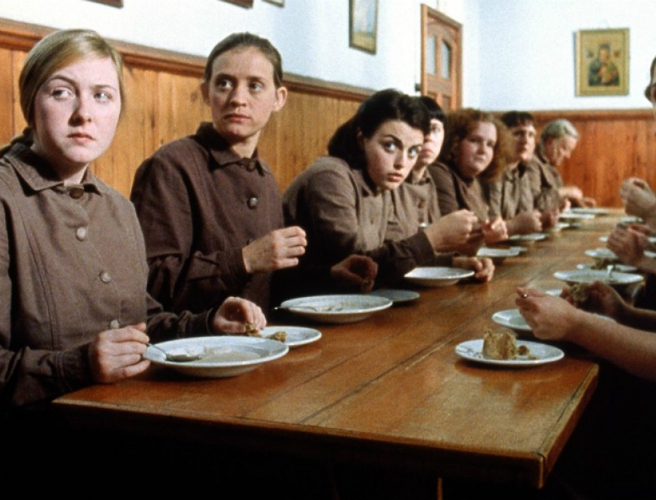 |
| Women in Magdalene Laundry |
The Catholic Church has always had a problem with women. What to do with them? The Church needs them, and wants to appear as though it respects them, but it does not want women to play any significant role in Church affairs.
Women appear to have been a problem from the very beginning. Although women were a respected part of Jesus' entourage and one or more may have been present for the Last Supper, Peter and Paul, following their Jewish and Mid-eastern roots, seem to have viewed women as hand-servants and wombs to bear offspring -- hopefully a preponderance of male offspring. (After all, a single male can impregnate many women, but a woman's birthing abilities are limited.)
And then when the writers of the Gospels came along, they had to deal with Mary, the mother of Jesus. They could not eliminate her. A human being, in this case, Jesus, has to have a mother; the father on the other hand can be ambiguous. The Gospel writers chose to make her a birth-mother, the concerned mother at the wedding feast of Cana, and a grieving mother at the crucifixion. Was she Jesus' educator and instructor or was she simply the woman who changed his diapers? The Gospels avoided that issue.
After the Church decided which Gospels to go with, it still had a woman problem. And since then the Church has wavered between making Mary a goddess on one hand, and a hand-servant on the other. There is a reluctance in the Catholic Church to admit that men and women are equal, but perhaps we should not be too surprised since the Catholic Church, a Medieval monarchy, does not understand democracy.
It appeared the Church had solved this problem with the "authorization" of Catholic Women's Religious Orders -- groups of women popularly known as "nuns"-- a term that has dubious connotations. (What does "nun" mean? Not male? Not significant?) But as it turned out, the women's religious orders took over the responsibility of fulfilling some of the Church's major social justice responsibilities by educating youth, tending to the sick, helping the impoverished, and caring for the elderly, the imprisoned and the mentally ill. The women of the Church excelled in carrying out the Christian mission.
Although women's religious orders seemed to provide a "place" for women in the Church, their "place" was one of subservience. The male pontiff and the male hierarchy were in charge and told the women what to do and how to live their lives. And it was within this context that abuses such as Ireland's Magdalene Laundries occurred.
Then in the 1950's Pope Pius XII told the women religious to modernize, to do away with outmoded practices that kept them from being in touch with the world around them. Along with the promise and encouragement of Vatican II, many of the women religious phased out their old habits -- their former mode of dress, and whole-heartedly embraced carrying their mission in the modern world They were free to use their talents and abilities and still be sisters in a religious organization. They became professors, scientists attorneys, community organizers and doctors while still practicing their religious and prayer life.
But then, in more recent history, under the rule of Pope Benedict XVI, the Vatican felt threatened by the independence and courage of the Women's Religious Organizations in the United States and appointed a few males (bishops) to investigate these women with an eye on keeping them from questioning some of the practices of the Church. Now it appears unclear what Pope Francis is going to do with this "investigation."
Pope Francis, in spite of his inclusive and democratic inclinations, also has a problem with women in the church. Recently, in a speech to Italian women, he spoke elegantly of the dignity of women, their "gifts of delicacy, ...a special sensibility and tenderness, ..feminine intuition,..and the richness of the feminine spirit," and then he goes on to speak " of women in the domestic ambit." He envisions "capillary and incisive roles" for women in the Church. He fails to elaborate what these roles might be; and in fact "capillary" tends to suggest secondary and subservient roles. Given the limitations the Church places on women, one has to conclude that the Church will continue to treat women as second-class citizens.
But we can still be hopeful. After all, we were told a black man could not be elected President. Then we were told it would not happen again, and he was re-elected. We were told that Benedict 16 had stacked the College of Cardinals to insure ultra-conservatives would be be chosen pope for the next fifty years. No one saw what was coming with Papa Francis. There is always hope.
No comments:
Post a Comment